The writing blog of oh-emdee. Not much here, just links to my writing and some advice/ideas main blog AO3
Don't wanna be here? Send us removal request.
Note
hey betts! can you give us any insight into your new drafting process (the one you mentioned on Twitter?) those results have me green with envy
sure! this is going to be a fairly quick run-down because i have to start planning my classes here soon.
(anon is referring to this tweet)
required reading
shitty first drafts by anne lamott, which is where i modified my process from
on fear by mary ruefle, which talks about procedure and i may have taken the wrong meaning from the essay but basically, my entire process is about mitigating the fear innate in writers’ block by having a procedure in place to counteract it
tools
google docs (or some other word processor)
google calendar (or some other calendar app; i wrote about my scheduling process here)
toggl (or some other timekeeping app)
airtable (i’ve also used trello, but i like airtable better. ps big thanks to @electricalice for introducing me to it! it’s a lifesaver)
pre-writing
so first you need an idea. whenever i have an idea, even if there’s 0 chance i’ll end up writing it, i add it to my airtable, plus any notes or details i come up with. i also copy and paste any text convos i have about the fic, like if i headcanon something with a friend. (i used trello for this until recently; it works just fine and is a bit easier to use. airtable also has a kanban function though, along with other formats, so it’s a bit more flexible)
airtable is a project management spreadsheet software. i’m sure there are others out there, but i started fiddling with this one and haven’t looked back. it takes a little while to figure out, and you might have to google some things you want it to do that aren’t terribly intuitive.
my fanfic table, filtered by ideas, looks like this:
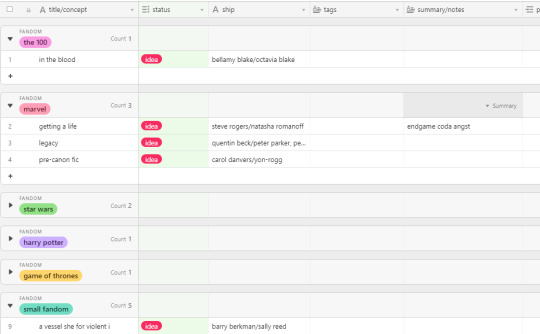
(you may have to expand to look at it, also note that the pretty colors are a Pro feature of the app and i’m still on my trial)
the idea here is to have space to store my ideas. let’s say i hang out with a friend and we started talking about fic, and i bring up i have an idea for a endgame coda but i’m not really sure where to take it, so we start headcanoning back and forth, and now i have a few scene ideas. i made my endgame coda card already right after i saw the movie, so all i have to do is open the app and jot down the main points of my headcanoning. now when i go home and start working on it, i can easily pull up our brainstorming session.
narrative outlining
i have never been an outliner or a planner. i’ve always been a pantser. i have a premise and i run with it, and that worked for me for a long time. pantsing has a lot of benefits: your story always surprises you! you can get really immersed! it’s certainly the more whimsical writing process.
but what i found was that i would often write myself into a corner, or lose steam once i realized what should have been a 10k fic was actually going to be 80k and i didn’t like the story enough to sit with it for 80k. i also spent a long time thinking about future scenes and writing them down but losing them later, or forgetting about them.
so i started doing narrative outlines, which are just me going “and then THIS happens” repeatedly and sometimes inputting “and something causes this other thing” until eventually i have the whole story written out. the goal of the narrative outline is pacing. all you have to do is get the major beats down. it doesn’t have to be good. no one is going to see it (unless you want them to).
ideally my paragraphs will be all around the same size. those are going to become my chapters. if a paragraph is significantly shorter than another, it’s likely that i don’t have that beat fleshed out yet. i call chapters “beats” because to me, each one should have its own arc, and end at a high or low point in the story.
in my fanfic airtable, i have a table for chapters. all chapters of all multi-chap wips go here, and i can filter out ones that are complete later.

the beauty of the chapters table is that it can connect to your ideas/wip table and vice versa so everything is kept together. i had 7 paragraphs in my narrative outline so i made 7 rows.
notice i also gave myself a due date. i don’t really like due dates, but i’m trying them on for now and seeing how it goes.
i copy and paste the chapter paragraph as i go into the “summary” field. then, as scene or line ideas come to me, i toss them in the “scenes/lines” field. I was in a car for 8 hours and coming up with scenes all over the place, and i needed somewhere to put them. if i didn’t know where they went, i put them in my idea table instead, and filed them later.
you’re still idea-ing, you’re still outlining, but now it’s time to write.
gauge
i make a folder for the fic and open a doc and label it ch1. then i copy and paste the narrative outline paragraph into the doc and separate it out by scene with an asterisk between each one.
here’s where the timesheet and calendar come in. i have a reminder on my calendar to schedule the following day, and on that schedule i put my writing time. when it’s time to write, i start the toggl clock. at the end of each week, i put in my time in my personal timesheet.
the first chapter or 10% of anything i’m writing tends to take longer than the rest, because i need to get into the story, and choose the voice and tense and tone and things like that. so i take however long i take to make what i call a gauge. in knitting, a gauge is the thing that determines the size of the piece. if you’re knitting a sweater, you knit a little square to make sure the sweater comes out the size you need it to be.
so i write the gauge and it takes however long it takes. sometimes i rewrite it a few times, test out POVs and tenses and description and whatever else. what i like best, what seems the most sustainable, is what i choose. i wrote 3 chapters of a novel in present tense and a childish tone before i decided it needed to be first person reflective and i rewrote the whole thing.
don’t get frustrated with yourself if your gauge doesn’t work. that’s what the gauge is for. you’ll know you’ve chosen the right voice if, by the end of your gauge, you’re really eager to keep writing.
down draft & punch list
so now you’ve got a pretty gauge to follow, and the rest is going to be an absolute mess. the down draft is exactly what it sounds like – you get the idea down. i personally believe you need to tell the story to yourself a few times in order to get good at telling the story, or to know what the story is. you’ve told yourself the story once in outline form, and now you’re just breaking out the scenes a little bit more.
the key to the down draft is not to self-edit. i’m not talking about going back and tweaking typos and shit, that’s fine, whatever. i mean doubting yourself structurally. like, oh shit, you forgot to mention that they took off their clothes and now they’re naked.
here’s where the punch list comes in, which is yet another table. (i’ve also used google tasks for this, because it pops up in a side window. either works!) a punch list is a to do list. instead of fixing things, you put the thing on your punch list and save it for the next draft. a down draft is all about speed and figuring out where all the pieces go. revising during the down draft only slows you down.
the punch list is my solution to the contrived advice “you can fix it later!” to which i always say, “BUT I WON’T REMEMBER TO FIX IT LATER I HAVE TO FIX IT NOW.” as soon as you think of something to fix, put it on the table. it may seem like it’s faster to fix things as you go. it is not. i promise.

this is all my punch list notes for all fics, which i then connect to my other tables/filter as needed. put everything in your punch list. it’s better to make a punch list item that you don’t end up implementing than forget an important revision note. if you end up putting the project down for a while, you’ll want to know what you’d intended.
up draft
in the up draft, you clean up the down draft. here, i take each document in a new window, put it on the right half of the screen, and open a new document to put on the left.
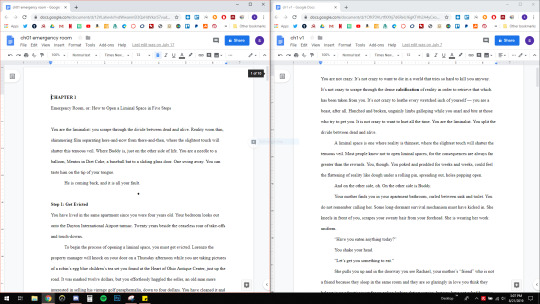
then i rewrite the whole fucking thing. i pull up my punch list and fix all the things as i go, to the best of my ability. here’s where the writing gets pretty and fleshed out. but still, it doesn’t need to be perfect. you have more revisions to go. it’s important to remember during this entire process that everything can be changed. nothing is permanent. you’re not writing in stone. there’s no cost to words or documents, so you can revise as much as you want.
it’s also worth noting that the longer your project, the more sectioned out your story will be. sometimes you’ll have a chapter on a down draft and another chapter on an up draft. sometimes you might down draft out of order just to make sure you get your ideas down when they occur. whatever works for you. the idea is that you’re constantly building spaces in which to put your stuff that can be easily found and implemented. the creative process is messy, so you need to make clean spaces to put the mess in.
while you’re up-drafting, you’re still idea-ing and outlining and down-drafting and punch-listing. maybe you don’t have the answer to a problem yet, but you might later. decision fatigue in the creative process is real. this process is designed to mitigate decision fatigue. there are only ever so many decisions to make at once when you expand out your process like this one.
and sometimes, sadly, the solution to a problem never happen. that’s okay. what you write might be flawed. in fact it should be flawed. flaws are what make things beautiful. all you can do is the best you can do, and if it’s not good enough for your tastes, you can learn from your mistakes and try again.
beta
sometimes i have a beta and sometimes i don’t, depending on how confident i am about the work. when i have a beta, this is the stage i send them my stuff. sometimes i tell them specific things i’m looking for, like just line edits, or cheerleading, or whatever else. sometimes i have questions about whether or not something is working. i tell them what date i intend to post and when i would like edits to be done by, and if they don’t get around to it, that’s okay. i can just hustle a little harder in the next revision.
dental draft
here’s where, per anne lamott, you check every tooth. i implement my remaining punch list items and beta feedback, fix pacing issues, typos, unclear sentences, etc. sometimes i do the side-by-side window thing for chapters that are particularly messy, and sometimes i just fix the existing doc. by now your story should be looking pretty good, or the best you can get it.
final read-through :) or additional revisions :(
for fic, this is the point where i hit it and hope. i copy and paste the chapter/fic into an ao3 shell with the tags and summary i’ve kept in my airtable, and do a final readthrough. i don’t do it in the original doc because seeing it in a new font and format usually makes me notice things i’d missed before.
for ofic, here’s where you might need more feedback and more revising if your piece isn’t working yet, or if you’ve submitted it a couple dozen places and haven’t had it accepted. while this process is thorough, sometimes pieces still aren’t working for whatever reason. don’t throw anything away, though. keep it, file it, log it in your airtable, and maybe one day while you’re driving an idea will pop into your head and you’ll be able to come back to it.
this was a really really quick run-down of an extremely long and complicated process, but it works for me! i probably wouldn’t have been able to do this even a year ago. it’s taken me a long time to cultivate this kind of discipline, and i’m still a work in progress. so if it’s too much or too structured for you, that’s fine. maybe you can take one or two things for yourself and try them out.
351 notes
·
View notes
Text
3 notes
·
View notes
Text
writing advice: sentence-level perspective & navigating the Show-Tell divide
right now i’m working on a lesson plan on narration for my CW class and i thought i’d share a portion of what i’m planning to go over with my students.
one of the the biggest overall weaknesses i see in writing happens at the sentence level, as in, i see many writers struggle putting “strong” sentences onto the page. conversely, the sentence-level advice i’ve seen that tries to counteract this weakness is often prescriptive. that is to say, it tells you what you should and shouldn’t do without any regard to context.
one such prescriptive piece of advice is Show Don’t Tell. for the uninitiated, Show Don’t Tell means that you should render an experience on the page rather than explain it. Show Don’t Tell is perceived as a dichotomy: you’re either showing, or you’re telling. Showing is always good and Telling is always bad. Showing is strong, Telling is weak.
but that’s not true on any level. first, there are many circumstances where you could choose to Tell and it is absolutely the right choice for the sentence. conversely, sometimes Showing is exhausting and potentially boring to read, and negates important internality (and voice!) of your narrator. i recently had a student who used Show to such a degree that i never had any idea what was going on, because he never Told a single detail, even to provide necessary information for the events that were happening. his writing was overall very strong, but i was lost. i told him it felt a little like walking into a grocery store without a cart, and having to balance all these items, these Show details, with nothing to put them in. you need Tell (a cart) just as much as you need Show (stuff to put in it).
second, Show Don’t Tell is a spectrum entirely reliant on perspective, which is where we get into the very difficult art of crafting a single sentence.
i was working on a story earlier today that i’m writing in very close third person. that means my POV character is She and the reader has complete access to the thoughts and feelings she has toward her environment. i came to an emotional high point between two characters, and wrote this sentence:
She can feel his heart pounding under her palm.
i erased it. i invoked a few prescriptive Rules i’d learned: Show Don’t Tell; Active > Passive Verbs; and When the Action is Hot, Write Cool. all of these come down to the same thing: in high-stake moments, create a wider distance between the reader and narrator. step further outside the mind rather than closer to it.
so i typed:
His heart pounds under her palm.
both of these sentences are solidly on the Show end of the Show-Tell divide, and in fact traditional writing advice would dictate that by all means, the second sentence is “stronger” than the first. but i disagree.
before i get into why, let’s take a step further back. let’s say i wanted to move closer to Tell. i have a lot of options. there are so many reasons someone’s heart might be pounding, and someone might have their hand against that heart. to Tell is to strip the reader of their interpretation. on one hand, as a writer sliding back and forth on the Show-Tell divide, you might not want any room for interpretation, and therefore the potential for misinterpretation. on the other hand, maybe you’ve developed the context of the moment so thoroughly that you’re comfortable allowing the reader their interpretation, and you’re confident it will reflect your intention for the scene.
in this case, i’ll whittle it down to the exact meaning of the sentence:
He’s nervous.
there are a few reasons i wouldn’t choose this sentence over one of the above. first, it doesn’t reflect the point of view. we have no idea who the narrator of this sentence is, and more importantly, we have no idea how she knows this information. does she think it? is it mere speculation, or is she absolutely certain? if the latter, what’s happening, or what is he doing, to convince her of it?
so, we’ll nix that sentence and move a little further down the divide.
She can tell he’s nervous.
now we have a little more context. we are solidly in the mind of one person, she, and we know that because she is having a thought/feeling. despite all writing tips and tricks you’ve ever read that tell you this is a “weak” sentence (because it Tells), i have no problems with it. i think it’s a fine sentence. here’s why:
it possesses internal voice and implies speculation and unreliability.
it has a conflict in it, which is to say it is a sentence that establishes a status quo and upends that which it establishes. the status quo is non-nervousness, non-speculation. we’re upending it by introducing nervousness and the speculation thereof. it innately encourages us to move to the next sentence.
sometimes there are no physical cues to Show nervousness. sometimes you can just feel it. maybe my narrator is highly intuitive. maybe she’s so close to him she just knows when he’s nervous. or maybe she’s completely wrong.
or it could be that after this sentence i’ll clarify what that looks like. maybe i’ll combine Tell and Show together so the reader has both a cart and a few items to put in it.
She can tell he’s nervous. He fidgets and plucks at a hangnail.
in a different scene, i would have nothing against opting for this Tell sentence and its corresponding Show detail. but in the scene i’m writing, where he is not actually fidgeting and plucking at a hangnail, i want to push further down to Show.
here was the sentence at my cursor:
His heart pounds under her palm.
by all means it’s a decent sentence. it implies POV, though a little ambiguously, because it’s her palm and she is actively feeling his heart beneath it. it has a visual, active verb: Pound. not Flutters. not Beats Steadily. not Thrums. you can see this happening, her hand on his chest, feeling his heartbeat. it possesses conflict: the word Pounds establishes the status quo (a normal hearbeat) and up-ends it (now his heart is beating faster).
the focus of this sentence, though, is not on her. it’s on him. context, voice, and POV all play a major role in deciding which sentence to choose. if i wanted a greater, more objective distance between my reader and our narrator (or in this case Writing Cool if we’re going by Gwartney’s Action Hot, Write Cool rule), and a closer distance between my reader and the action of the present moment itself, i would choose this sentence.
but i don’t want that. i erased the sentence above and went back to my original.
She can feel his heart pounding under her palm.
the emphasis of this sentence is no longer on him, nor the action of his heart. it’s on her, and the fact that she can feel it. i’m choosing to keep us closer to the narrator’s perspective and further from the action. i’ve decided that it’s more important to wrap the action of this moment up in her perspective – to put this detail in a cart, if you will. i’ve chosen the weaker sentence in order to convey narration, to keep us close to the mind rather than the body, to show this action through a window rather than straight-on.
none of these sentences are, by themselves, better or worse, stronger or weaker, than others. these sentences illustrate a choice you the writer have to make over and over again, sentence by sentence, in order to support and develop the voice, tone, and conflicts you’ve established, regardless of the prescriptive advice you might believe.
writing advice tag | ko-fi
2K notes
·
View notes
Photo





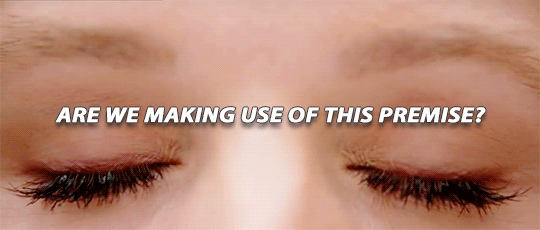
“Before the writers started working on the first season, I wrote a list of six things on the wall that every episode had to do.” - Mike Schur (x)
126K notes
·
View notes
Link
Chapters: 1/1 Fandom: Overwatch (Video Game) Rating: Teen And Up Audiences Warnings: No Archive Warnings Apply Relationships: Genji Shimada & Jesse McCree, Genji Shimada & Angela "Mercy" Ziegler, Genji Shimada & Moira O’Deorain Characters: Genji Shimada, Jesse McCree, Angela "Mercy" Ziegler, Moira O'Deorain Additional Tags: Genji Shimada-centric, Blackwatch Era, Genji questioning his humanness, Body Horror (only because of his issues with his robot half) Summary:
Genji questions how human he really is, and Moira lays down some proof.
My second (and last) Blackwatch Week submission. This one is all about Genji. Genfic again.
2 notes
·
View notes
Link
Chapters: 1/1 Fandom: Overwatch (Video Game) Rating: Teen And Up Audiences Warnings: No Archive Warnings Apply Relationships: Jesse McCree & Reaper | Gabriel Reyes Characters: Reaper | Gabriel Reyes, Jesse McCree, Fio (Blackwatch), Gérard Lacroix, Original Blackwatch Agent, Original Deadlock Gang Character(s) Additional Tags: First Meetings, Background Character Death, Drug Use, Jesse is high when they meet, Blackwatch Week Summary:
An attempted clean-up of Deadlock Gorge gone terribly wrong leads to the fortuitous meeting of Gabriel Reyes and everyone’s favourite cowboy.
This was actually my first submission to Blackwatch Week 2018, but I forgot to post it over on this blog, so I thought I should do so just to have everything in one spot. Genfic Jesse & Gabe
1 note
·
View note
Text
When a character doesn’t realize they’ve been, like, shot or whatever and they hand brushes against their side and comes away wet with blood, and they’re just staring at it like wtf is this and then their knees just totally give out on them and they sink down, maybe gasping a little as the reality finally hits them. That’s good stuff.
319K notes
·
View notes
Text
Publishing for Fun and Profit
So there was a list going around tumblr for a while that made it to my dash of literary journals that accept open submissions (and will pay!), but upon inspection about half of them were closed indefinitely, and I found quite a few other places that looked interesting through further research, so I wanted to post my own list.
I tried to focus on things that paid professional grade (at least 6 cents per word), were friendly to speculative fiction, and specifically encouraged diversity and writing about marginalized groups.
(Please note that as of right now I have never submitted or been published with any of these, so if anyone has experience with them, good or bad, please feel free to message or reblog this with your experiences.)
Speculative Fiction
Strange Horizons — Speculative fiction (broadly defined) with an emphasis on diversity, unusual styles, and stories that address politics in nuanced ways. 8c per word. Up to 10,000 words, under 5,000 preferred. Responds within 40 days. LGBT+ positive.
Fantasy & Science Fiction Magazine — Sci-fi, fantasy, horror, etc. 7-12c per word. Up to 25,000 words. No response times listed.
Asimov’s Science Fiction — Primarily sci-fi but accepts fantasy and surreal fiction, but no high fantasy/sword and sorcery. Prefers writing that is character driven. 8-10c per word. 1,000-20,000 words. Responds in about five weeks.
Evil Girlfriend Media — Horror and urban fantasy centered on female empowerment and defying gender stereotypes. $100 flat payment. 4,000-7,000 words. No response times given. LGBT+ friendly.
Beneath Ceaseless Skies — Fantasy with a focus on secondary worlds and characters. 6c per word. Up to 10,000 words. Average response time 2-4 weeks.
Fantastic Stories — Speculative fiction with an emphasis on diversity and literary style. 15c per word. Up to 3,000 words. Responds within two weeks. LGBT+ positive.
Fiction Vortex — Serialized fantasy and speculative fiction. $300 for featured stories, $50 otherwise. 3,500 words or less. No response times given.
Shimmer — Speculative fiction with an emphasis on diversity, strong plots, vivid characters, and beautiful writing. 5c per word. 7,500 words or less (will consider longer words with query letter). Usually responds within two weeks. LGBT+ positive.
Clarkesworld Magazine — Sci-fi, fantasy, and other speculative fiction. 10c per word up to 5,000 words, 8c per word after. 1,000-16,000 words. Responds within days usually, gives a tracking number.
Apex Magazine — Speculative fiction of all kinds. 6c per word, +1c per word for podcast stories. Up to 7,500 words, all submissions over will be auto-rejected. Responds within 30 days.
Heliotrope Magazine — Speculative fiction of all kinds. 10c per word. Up to 5,000 words. Responds within 30 days.
Lightspeed Magazine — Speculative fiction of all kinds, with creativity and originality in terms of style and format encouraged. 8c per word. 1,500-10,000 words, under 5,000 preferred. LGBT+ positive. Submissions temporarily closed for their main magazine but is accepting for their People of Color Destroy Science Fiction special.
General Fiction
The Sun Magazine — General fiction, likes personal writing or writing of a cultural/political significance. $300-$1500 flat payment and a one year subscription to the magazine for fiction (also accepts essays and poetry). No minimum or maximum lengths but over 7,000 words discouraged. Responds in 3-6 months. Physical submissions only.
One Story — Any and all varieties of fiction, “unique and interesting” stories encouraged. $500 payment plus 25 contributor copies. 3,000-8,000 words. Usually responds in 2-3 months.
Camera Obscura — General fiction. $1000 for featured story, $50 for “Bridge the Gap” award, no payment for other contributors. 250-8,000 words. Response time vary, running just over two months as of now.
Flash Fiction
Daily Science Fiction — Speculative flash fiction (including sci-fi, fantasy, slipstream, etc.). 8c per word. Up to 1,500 words, but shorter stories given priority. Response times not listed.
Vestral Review — General flash fiction. 3-10c per word depending on length to a max of $25. Up to 500 words. Response within four months.
Flash Fiction Online — General flash fiction. $60 flat payment. 500-1,000 words. Response times not listed.
Novels/Novella
Riptide Publishing — Any LGBTQ manuscripts between 15,000 and 150,000 words. Currently especially interested in lesbian romances, trans stories, asexual/aromantic stories, romances with a happy ending, and genre fiction such as urban fantasy. Also has a YA branch. LGBT+ positive.
Crimson Romance — Romance stories of all kinds, currently seeking LGBT+ stories with a focus on emotional connections and relationships, especially m/m romance. Novel (55,000-90,000 words) or novella (20,000-50,000 words) length. LGBT+ positive.
Kindle Direct Publishing
Kindle Direct Publishing — Allows you to set your own prices, create your own cover art, and make royalties off of each sell. Any and all genres are welcome and if you’re prolific and smart about how you’re publishing you can make pretty good money.
General Guide to Kindle Publishing — Gives a good rundown of the publishing process on Kindle.
101 Guide to Kindle Erotica — Great guide with lots of resources about how to make money publishing erotica on Kindle.
Publishing Comics/Graphic Novels
Here is a list of potential comic companies and what kind of open submissions they accept.
Here is a list of literary agents who accept graphic novels.
34K notes
·
View notes
Text
Writing Exercises for Stretching Your Style Muscles
There’s a lot of writing advice on the internet, and a lot of writing prompts, but something I see relatively little of is an idea of how to actually practice.
The thing about learning a skill is that it requires practice – but practicing will only get you so far if you’re just doing the same thing over and over. you might get better at doing that specific thing, but it can seem really difficult to get over a specific hurdle to accomplish some new thing you’ve never tried. I think a really common frustration is wanting to do a thing, and knowing what your end goal looks like, but not knowing actually how to accomplish it.
So that’s where practicing specific skills can really help you to feel more comfortable with your abilities.
Here are some skills exercises I recommend experimenting with to gain proficiency and comfort in writing things.
—–
Write the Same Scene from Multiple POVs
Write a scene in 3rd person POV. Then go back and rewrite it from scratch in 1st person. Repeat for a 3rd person omniscient. Go deeper than just swapping out pronouns. Think: How does this scene change if I’m writing through the eyes of a single character vs over their shoulder? How does this scene change if I’m narrating the events through Character B instead of Character A?
—-
Write a Scene in Present Tense
Present tense bumps up the immediacy level of whatever you’re writing. I think it also helps to break you from more passive sentence constructions. Try taking a scene you’ve written and rewrite it in present tense. Combine it with the above – try switching a 3rd person past to 1st person present, or even try writing in 2nd person.
—–
Try Mimicking Another Writer’s Style
Sit down with a piece of writing from an author you enjoy, and pay attention to the writing itself. Ignore the plot and characters and story elements – look at just the nuts and bolts of vocabulary choices and sentence construction. Try to pick it apart. Is there a specific way the author tends to use commas? Certain words, or types of words, that they use more often? Longer sentences or shorter ones? Longer paragraphs or short? How is white space handled?
Study that and make yourself a little cheat sheet if that’s helpful to you. Then try writing a short piece – just a couple paragraphs, even – in their writing style.
—-
Describe an Entire Scene Without Using Visual Description
Imagine you’re writing a blind character, if it helps, or someone who’s been blindfolded. Describe a whole scene built entirely around the way things sound, smell, taste, feel. Try to make it clear what’s happening through description alone.
—–
Eliminate All Words like “Thought” or “Felt”
Write in deep-3rd or 1st person without any filter words. Make a character’s opinions and emotions obvious through the way things are being described without explicitly saying what they’re thinking or feeling. If you struggle with this, it might be easier to start in first person – write as a diary entry or even a Tumblr post from that person’s perspective – and then try it in 3rd person after you’ve had a bit of practice.
——-
Set Yourself a Specific Goal, and Write a Drabble to Achieve it
When I wrote “Happy Ending,” my entire goal was to write something that was highly descriptive in the most viscerally gross way possible. When I wrote “Mothman,” it was an exercise in writing something sexualized without explicitly being sexual, in the most disturbing way possible.
This is an exercise in word choice. It’s an excuse to bust out your thesaurus, not to sound fancy, but to nail a specific meaning. It’s also an exercise in choosing what details to focus on and which to exclude.
One way to approach this exercise is to describe something common and mundane that you’ve experienced, and write it in several different ways. Let’s say, eating a sandwich. How can you make eating a sandwich sound sexy? How can you make it sound disgusting? Which details do you focus on, and which do you omit? What words do you use to evoke the meaning you’re looking for?
—————————————————————
I hope these writing exercises give you some inspiration on things to try out to flex your creative wings a bit!
10K notes
·
View notes
Text
Resources For Describing Emotion
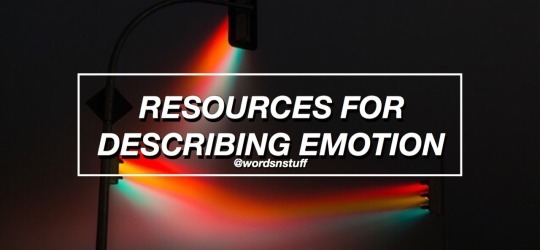
Emotions
Without Making Your Character Feel Too Self Aware
Showing Emotion Without Telling About It
Emotions Associated With Body Language
Telling Readers What The Character Doesn’t Want To Show
Hiding Emotions
Expressing Cardinal Emotions: Masculine vs. Feminine
Writing Extreme Emotion Without Melodrama
Specific Emotions
Conveying Shock
Conveying Embarrassment
Conveying Disappointment
Conveying Love/Attraction
Conveying Annoyance
Conveying Relief
Conveying Uncertainty
Conveying Impatience
Conveying Shame
Conveying Resentment
Conveying Panic
Conveying Guilt
Conveying Desperation
Conveying Sarcasm & Verbal Disrespect
Conveying Confusion
Conveying Stubbornness
Conveying Frustration
Conveying Indifference
Conveying Indignation
Conveying Confidence & Pride
Conveying Smugness
Conveying Enthusiasm
Conveying Curiosity
Conveying Hopefulness
Conveying Unease
Conveying Reluctance
Conveying Worry
Conveying Humility & Meekness
Conveying Happiness & Joy
Conveying Amusement
Conveying Disgust
Conveying Resignation
Conveying Jealousy
Conveying Anticipation
Conveying Contentment
Conveying Defeat
Conveying Excitement
Conveying Fear
Conveying Hatred
Conveying Hurt
Conveying Being Overwhelmed
Conveying Sadness & Grief
Conveying Satisfaction
Conveying Somberness
Conveying Sympathy & Empathy
Conveying Wariness
Conveying Defensiveness
Conveying Desire
Conveying Doubt
Conveying Energy
Conveying Exhaustion
Conveying Hunger
Conveying Loneliness
Conveying Physical Pain
Emotional Wounds
A Role Model Who Disappoints
A Sibling’s Betrayal
A Speech Impediment
Becoming a Caregiver at an Early Age
Being Bullied
Being Fired or Laid Off
Being Held Captive
Being Mugged
Being Publicly Humiliated
Being Raised by Neglectful Parents
Being Raised by Overprotective Parents
Being So Beautiful It’s All People See
Being the Victim of a Vicious Rumor
Being Stalked
Being Trapped in a Collapsed Building
Being Unfairly Blamed For The Death of Another
Childhood Sexual Abuse (by a family member or known person)
Discovering One’s Parent is a Monster
Discovering One’s Sibling was Abused
Experiencing a Miscarriage or Stillbirth
Failing At School
Failing To Do The Right Thing
Financial Ruin Due To A Spouse’s Irresponsibility
Finding Out One’s Child Was Abused
Finding Out One Was Adopted
Getting Lost In a Natural Environment
Growing Up In A Cult
Growing Up in a Dangerous Neighborhood
Growing Up In Foster Care
Growing Up In The Public Eye
Growing Up In The Shadow of a Successful Sibling
Growing Up with a Sibling Who Has a Chronic Disability or Illness
Having Parents Who Favored One Child Over Another
Having To Kill Another Person To Survive
Infertility
Infidelity (emotional or physical)
Losing a Limb
Losing a Loved One To A Random Act of Violence
Making a Very Public Mistake
Overly Critical or Strict Parents
Physical Disfigurement
Rejection By One’s Peers
Telling The Truth But Not Being Believed
The Death of a Child On One’s Watch
Victimization via Identity Theft
Watching A Loved One Die
Wrongful Imprisonment
Spending Time In Jail
Suffering From a Learning Disability
Motivation
Achieving Spiritual Enlightenment
Avoiding Certain Death
Avoiding Financial Ruin
Beating a Diagnosis or Condition
Being Acknowledged and Appreciated by Family
Being a Leader of Others
Being the Best At Something
Caring for an Aging Parent
Carrying on a Legacy
Catching The Bad Guy or Girl
Coming To Grips With Mental Illness
Discovering One’s True Self
Escaping a Dangerous Life one Doesn’t Want
Escaping a Killer
Escaping a Widespread Disaster
Escaping Confinement
Escaping Homelessness
Escaping Invaders
Finding Friendship or Companionship
Finding a Lifelong Partner
Having a Child
Helping a Loved One See They Are Hurting Themselves and Others
Obtaining Shelter From The Elements
Overcoming Abuse and Learning To Trust
Overcoming Addiction
Protecting One’s Home or Property
Pursuing Justice For Oneself or Others
Realizing a Dream
Reconciling with an Estranged Family Member
Rescuing a Loved One From a Captor
Restoring A Name or Reputation
Righting a Deep Wrong
Seeking Out One’s Biological Roots
Stopping an Event From Happening
Trying Again When One Has Previously Failed
Support Wordsnstuff!
Request A Writing Help Post/Themed Playlist/Writing Tips!
Send Me Poetry To Feature On Our Instagram!
Receive Updates & Participate In Polls On Our Twitter!
Like us and share on Facebook!
Read More On Our Masterlist & See our Frequently Asked Questions!
Tag What You Want Me To See With #wordsnstuff!
Participate in monthly writing challenges!
108K notes
·
View notes
Text
NaNo Prep: How to Go From Plotless to Polished

November is just around the corner, and as we gear up, we’re sharing advice on how you can best prepare for a month of writing. Today, author and designer Derek Murphy shares his advice on how to turn a messy work-in-progress into a polished draft in November:
NaNoWriMo is a great opportunity to push your boundaries and see how much writing you can get done in thirty days. If it’s your first time shooting for 50K, write whatever is easiest for you. However, if you’ve been doing NaNoWriMo for a few years and have struggled to turn your newly generated manuscript into an actual book that sells, here’s some advice that should help:
Save a Darling—Plot Ahead
First of all, if you started your story with very little plotting, it’s likely you have dozens of powerful scenes but no backbone to hold it all together. And it’s very difficult to go back and operate on your manuscript after it’s finished. “Kill your darlings” is good advice, but painful for a reason. It’s hard to cut the stuff you love—but if it confuses the narrative or doesn’t need to be there, it’s hurting the story.
Keep reading
386 notes
·
View notes
Photo

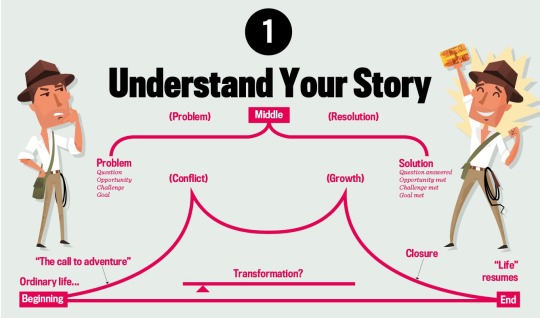





Seven Steps to the Perfect Story
From structure and plot to heroes and characters, your story must have everything in place if it’s to connect with the reader. Follow our guide to storytelling success.
122K notes
·
View notes
Text
Underwriting: ways to boost your word count
I wrote a fic recently and the word count for the first draft came to about 40,000 words – roughly the length of a novella or ficlet. And that’s fine because I wasn’t striving for a novel or a 100K slow-burn coffee shop AU.
But coming to edit my first draft I realised something about myself. I am an underwriter. My fic could actually be at least 10k (maybe 20k) longer. Of course it’s not all about word count, it’s about the story, but in this case a smaller word count isn’t because I’m a fantastically efficient storyteller it’s because I’ve missed out a lot of stuff. Like, Important Stuff.
So as I set out to add muscle to the skin and bones I’ve already created in draft one I thought I’d share five tips for my fellow underwriters to help you flesh out your writing too.
1) Make sure to describe the place and space in which the action happens.
There are quite a few places in my first draft where there’s no indication as to where things are taking place– or there is, but it’s the bare minimum and not really enough to build up a clear picture. This probably because as the writer I know exactly what the place looks like so I make the assumption that a bare minimum description will mean the reader knows too.
Now I’m not saying go into masses of detail about what your settings look like. In some cases it’s not useful to describe setting in a lot of detail (e.g. during really fast paced action sequences) but doing a verbal sketch of the space is essential for putting your characters in context and reader understanding.
I really is a fine balance (which is why beta readers are your friend!) But definitely go back to your setting descriptions if you’re an underwriter, they might need some work.
2) Make sure to describe your character’s appearance.
Similar to the above point – you know what your characters look like, but unless you describe them, the reader won’t.
It’s fair to say that descriptions are open to reader interpretations, but that doesn’t mean you shouldn’t describe them in a healthy amount of detail. So you might try to nail down some of the interesting quirks about your characters to help the reader build a picture – not only will it help the readers understanding, it’ll boost your word count too!
Note: This one functions a little differently in a fic because the readers are probably familiar with how the character looks, but there is nothing wrong with adding your interpretation (or even reminding them, especially if the characters are from a book.)
3) Include character reactions outside of what they say out loud.
Real life conversations aren’t just about the stuff that comes out of our mouths. So much of human interaction is about body language – so include it in your writing! Saying that the character covers their mouth with their hand when they talk suggests shyness. While another character crossing their arms shows they’re defensive -perhaps because they’re feeling threatened. In real life we don’t always say what we mean – but a lot of the time our actions give away what we’re really thinking. By including these actions around dialogue writers can influence how we as readers view characters and how we interpret interactions between characters. And it can boost your word count too.
The big stuff:
4) Check your pacing.
When you write it feels like your scene is taking place over hours, days, weeks because when you’re writing it takes time. Reading, on the other hand, is much quicker. A seasoned reader can fly through a 100 page novel in a few hours – a seasoned writer can spend hours writing a 100 words.
When you read back your writing, make sure to check your pacing. You might just find that the Impossible Task you set for your characters at the start of the story is suddenly resolved within the next fifty pages. To boost your word count you might want to start by adding more obstacles between the character and their goal.
For example; your character has to find an object such as a precious jewel. Sounds relatively easy, right? But what if the jewel is lost in the mines of an ancient people, amongst thousands of other treasures that look very similar? What if no one has found this jewel because it’s guarded by a fire breathing dragon? What if the ancient mines and dragon are located in a mountain which is miles and miles away across dangerous lands? What if your characters need to enlist the help of someone with a very specific skill set?
You take one simple objective (finding the jewel) and you put into play a series of obstacles that must be overcome in order to complete the objective. Your underwriting tendencies, like mine, might just mean that there aren’t enough metaphorical (or real) dragons in your story!
5) Sub-plots.
A sub-plot is a smaller scale plot - often involving the supporting characters - which runs secondary to the main plot. It can be directly linked to the main plot, i.e. the info provided in the subplot directly influences events in the main plot. Or it can simply be linked through place, time or themes of the overall story (e.g. Hermione’s elf rights campaign ‘S.P.E.W’ in Harry Potter and the OoTP is linked to the overall theme of oppression.)
Sub-plots are great because they can serve as some respite from a traumatic main plot; your character is fighting a war (main plot) but also fighting and failing (in hilarious ways) to win the affection of their love interest (sub-plot).
Plus, sub-plots can also help with characterisation, can cause your main character to have the moment of realisation which allows them to overcome the obstacles they face in the main plot and is generally a better reflection of real life! Sub-plots often centre on side-kicks and other characters – people who might not be as devoted to the end goal as the protagonist is. In fact, well written side characters seemingly live their own lives with their own goals. You might choose to showcase this in your sub-plot by letting the conflict of interest cause more problems for the protagonist to overcome.
Either way you could find your word count sky rockets as soon as you add in a few clever sub-plots.
I hope this helped!
Got any questions? Send me an ask
11K notes
·
View notes
Photo
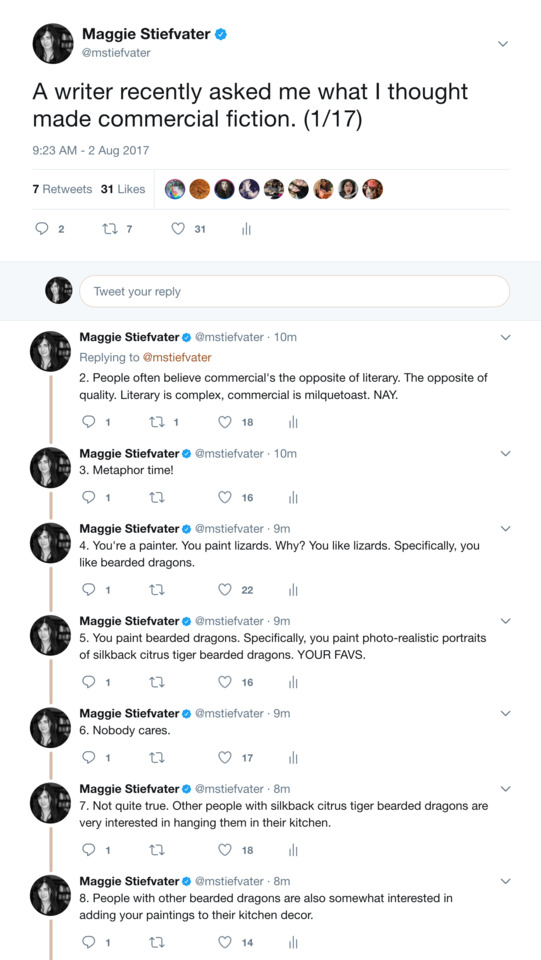
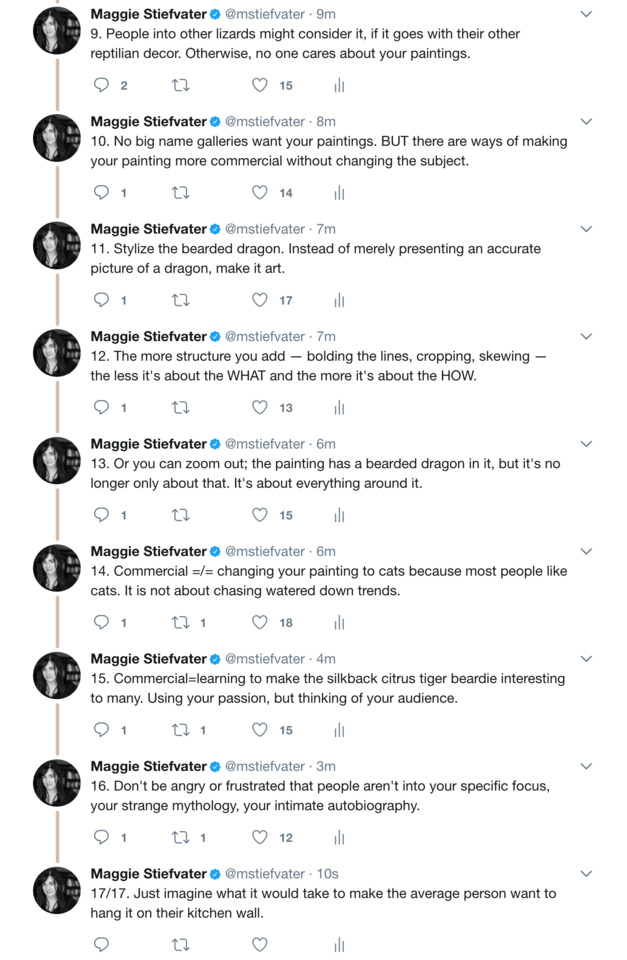
x
3K notes
·
View notes
Photo
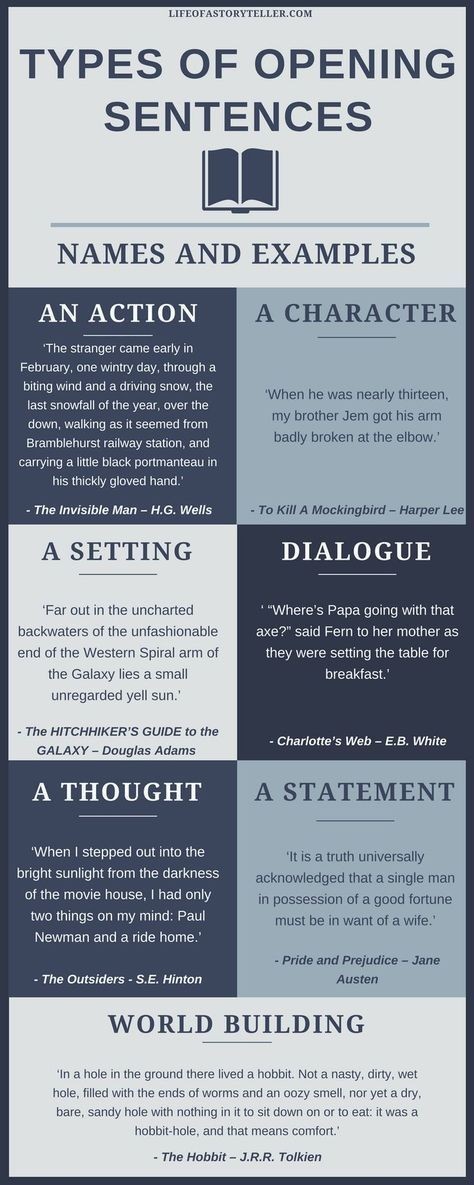
Credit: Lifeofastoryteller.com
8K notes
·
View notes
Note
hope you dont mind me popping in again, this time with a bit of a writing question more or less? see ive been struggling with writing good solid action scenes as of late and i know it'd be a lot to ask but i was wondering if you had any advice?
Well, they always seem like they’re going to be a challenge–people always say they lose track of who is where, etc–but the truth is I go at them the same as I go at every type of scene I do. I visualize the scene in my mind and keep track of each person, making sure they are always doing something–even if that something is just leaning against a wall, or fiddling with something in their hands. I can do that fairly well without a reference (many years spent playing D&D will do that to you) but if you need to you can make a diagram of the battlefield/room/wherever. It doesn’t have to be fancy, but just knowing McCree is behind this box, Hanzo is up on this balcony, Mercy is behind the payload–then when you move them on the diagram, move them in the story. Easy peasy!It’s important that everyone has a role. Overwatch makes it fairly easy–they all already have roles, but working it into a fic convincingly means considering motivations, what the mission is other than “move the payload” and things like that. But if we ignore all that, making sure everyone is doing the job that they’re good at helps. Or, alternatively, a job they aren’t good at for added drama.It sounds cliche, but think of framing the actions like you would a movie. My background is more in visual arts so I spend a lot of time imagining scenes like something I would want to watch myself.One thing I see people do a lot that is detrimental is just relying too much on visuals. No matter how dynamic the action is in your head, if all you do is describe what it looks like it still becomes boring. Remember the other senses and the environment! The smell of gunpowder, the taste of kicked up dust, deafening blasts, the lighting, the atmosphere. All those elements add so much drama and can help set the tone. Then, there is what I think most people find to be the hardest part: After you write an action scene (or any scene but especially action) reread it with an objective eye. Can you follow the action without getting lost? Does anyone suddenly appear somewhere without explanation (which can be good only if it was intentional.) Does anyone move a distance far faster than they should be capable? Does someone have way more ammo than makes sense? Did it have you on your toes? Bored? Confused? If you read it and can’t tell, find a beta that can help! An HONEST beta, and don’t be afraid of constructive criticism!I hope some of that was helpful, this was just off the top of my head. If you have any more specific questions feel free to ask! I totally don’t mind at all!
12 notes
·
View notes
Text
Why do really bad books always have to go out of their way to describe how characters, particularly women but damn if every gender doesn’t get the same stupid treatment depending on who the writer is, are attractive?
You know, you get the sentence of description and it always begins with, “They were an attractive (blank) blah blah blah bullshit bullshit.” It always has to begin with the fact that they’re attractive.
A particular book I’m reading at the moment, one which I’ll likely burn upon finishing it’s that fucking awful (and I *love* books), seems cursed to introduce female characters in the same way: “She was attractive”, “She was surprisingly beautiful”, “She was just as gorgeous he remembered”. I’m serious, it has happened every single damn time, and it’s pissing me off so fucking goddamn much.
I dunno why. It’s not like I’m against characters being attractive, but it’s so goddamn lazy to say “They are attractive”. Is it so much to ask, “Why?” Why are they attractive? What’s so beautiful about them??? Can I have one fucking goddamn female character in this stupid bastard son of a bitch book that doesn’t immediately have their looks brought into who they are? I mean, thank god for books that don’t do this. Thank god for books that just describe their character, and *you* get to decide if they’re attractive or not. Thank god for books that don’t rely on “This character is pretty” to make them interesting. Thank you, books that do that. I really fucking miss you right now.
427 notes
·
View notes